FAQ - Frequently Asked Questions
Screen protectors are available in different forms and qualities - as display foils, as flexible glass or as glass foils (hard glass or bulletproof glass). In order to answer the most important questions about screen protectors in a condensed form, we have summarized them as FAQ - Frequently Asked Questions. If you have any further questions, you easily can contact us.
Display protection guide
Frequently asked questions and their answersAnti Glare screen protection effect
Why display protection? The high-quality display is very robust after all!
Antireflective treatment of displays and screens
It's not only about the scratch protection of surfaces and screens, but also about the topic of anti-reflective coating for reflective and glossy displays, also called bright display, glare display or clear bright. In addition, modern displays are very expensive and even the smallest scratches can interfere with the readability and the look! Of course, there are quite good polishing pastes for displays, which can polish out small scratches from plastic displays. However, scratches in glass displays cannot be polished out!
Display protection from mechanical damage
However, it is much better and more convenient to equip your device display with professional display protection in advance. The following feedback on the quality of Neoxum films was sent to us by an industrial customer. Our customer is a metalworker and deals with sharp metal objects on a daily basis. He carries his Apple IPhone 3GS with him in the production shop. Due to carelessness, a piece of sharp metal weighing approx. 200 g fell onto his Apple iPhone 3GS from a few centimeters away. By using the Neoxum AS scratch protection film with 0.13 mm thickness, a display damage could be avoided. The display film was quite badly affected, but the Apple IPhone 3GS display remained unharmed. The protective film can be replaced at any time without leaving any residue. A new display protection film protects the smartphone's display that remained intact.
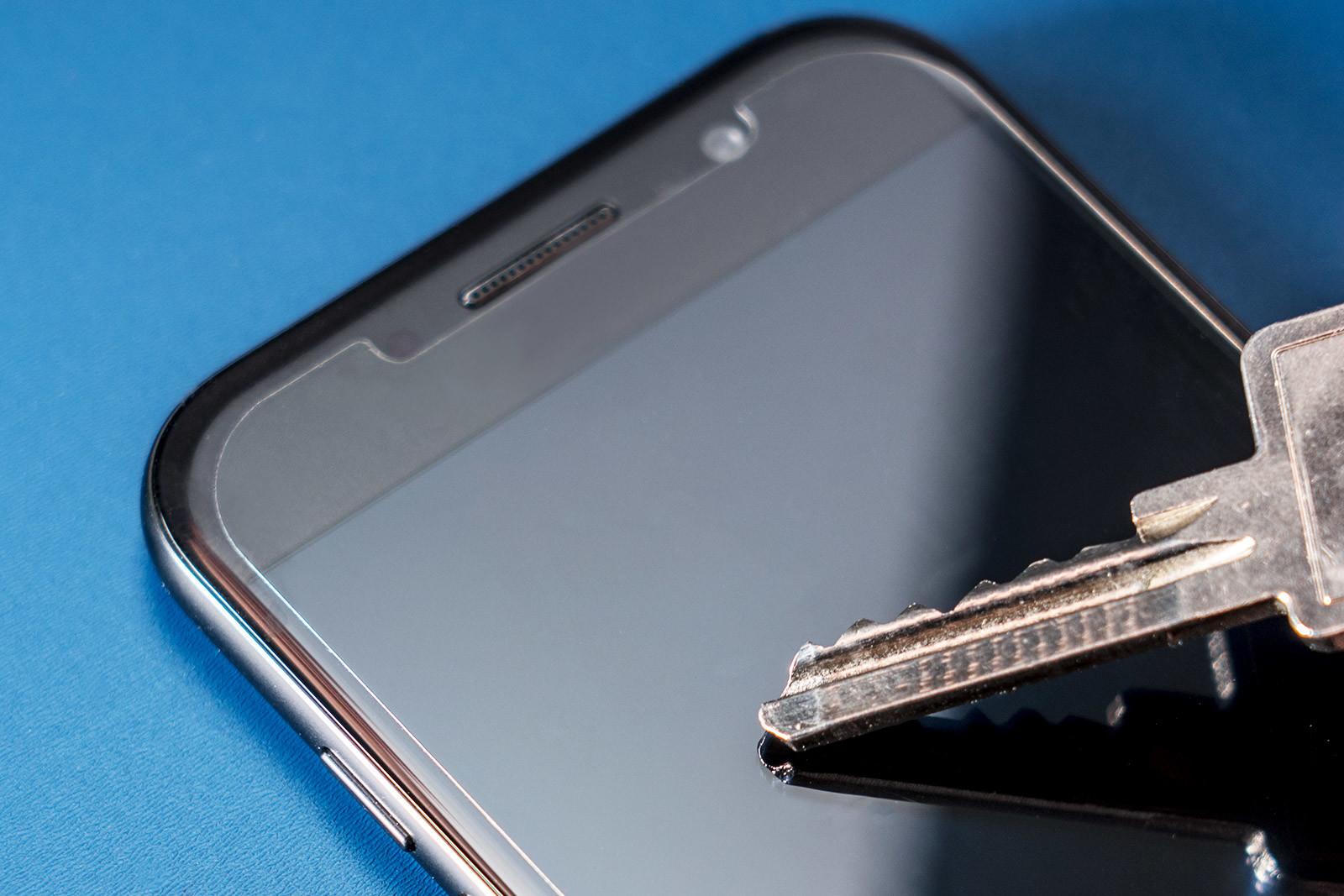
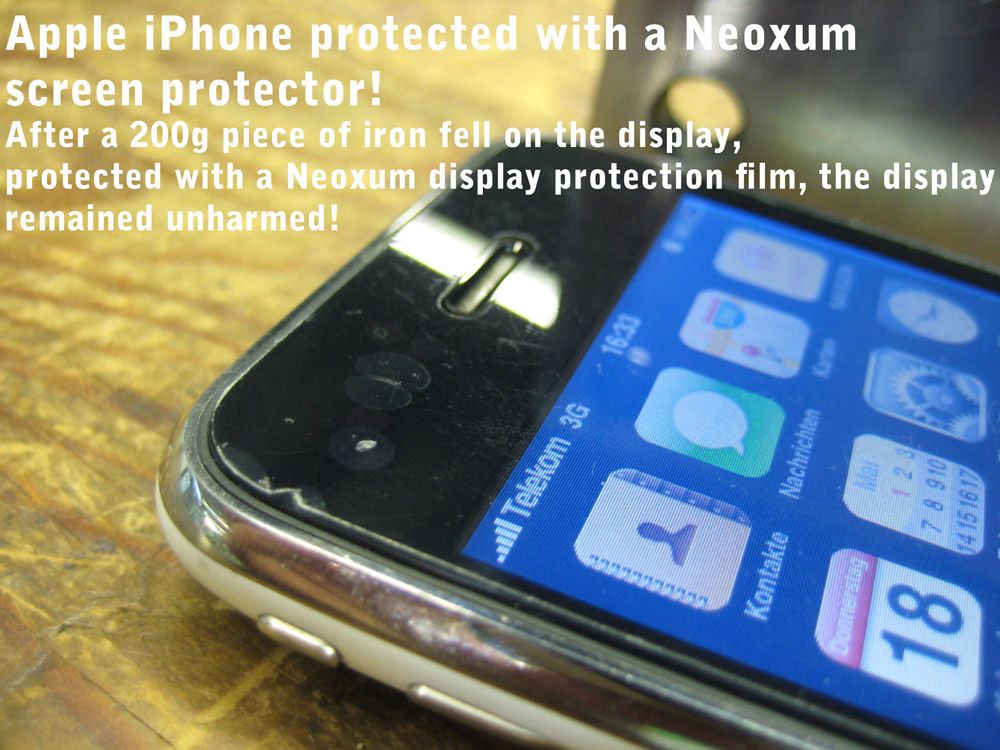
Datasheet Neoxum screen protection foils
Effective antireflection coating of displays
Problem description reflections on display
Reflections on the display are quite annoying and distracting. Besides the reduction of the image contrast, important elements and information on the display are partly completely obscured. A further negative effect is the reduction of the visually recognizable color dynamics due to the bright environment or with peak lights, which create a strong reflection on the device display. Another problem is the different focus of the human eye on reflections. These are mostly due to point light sources a few meters away, such as lamps, or windows through which daylight penetrates. Our human vision is very irritated by this: Should the eye now focus on the mostly very bright reflection or on the screen content? A comparison of the brightness of a display, e.g. a good cell phone display of an iPhone or Samsung smartphone with 600 -1000 lux with a modern office ceiling LED lamp with 30 watts at 2500 lumens, a beam angle of 35° and a distance to the viewer or cell phone display of 2.5 meters, gives the following result: The ceiling LED still has about 1300 lux at this distance under the above assumptions. Accordingly, the point light source is 1.3x to 2x as bright as the light source in the display, depending on the situation and the screen brightness setting of the smartphone. We will spare a comparison to the sun at this point: Everyone knows the enormous luminosity of our fixed star, which makes it almost impossible to read information on a reflective display outdoors.
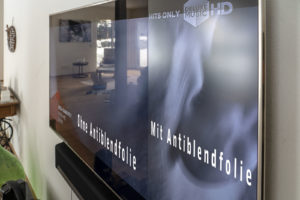
Comparison between reflections on a Samsung UE55D8000 LCD TV: left side without anti-reflection screen protection foil | right side with Neoxum anti-reflection screen protection film
Antireflection coating by means of λ/4-layer films
With the help of a factory-applied anti-reflective layer or subsequently applied λ/4-layer film, some manufacturers reduce the reflection on the reflective display. These anti-reflective coatings are very often called λ/4-layer because the anti-glare effect is based on the destructive interference effect. Unfortunately, this type of anti-reflective coating also makes itself unpleasantly noticeable with a purple-blue color cast, since the relatively short-wave green range around 550 nm is filtered out and the addition of the remaining color components cause this blue cast. A disadvantage of this λ/4 layer is also the limited effect with point sources and their point reflection.
Anti-glare due to matte antireflection coating
Bei älteren Displays, wie z.B. ältere Apple iMacs konnte man durch einen matten Displayschutz die Spiegelung sehr gut reduzieren. Leider verlor man aber auch an Schärfe des Bildschirminhalts, da der Abstand zwischen dem Bildschirmglas und dem eigentlichen LCD Display relativ groß war. Glücklicherweise ist der Abstand zwischen Deckglas bzw. Display und dem eigentliche LCD, LED oder OLED Bildschirm bei den meisten Display Modellen sehr gering (oder überhaupt nicht mehr durch neue Technologien vorhanden), so dass man mittels matter Streuung der Spiegelung eine sehr effektive Entspiegelung erreicht. In nachfolgendem Beispiel haben wir einen LCD-TV Samsung UE55D8000 Fernseher von 2011 auf der rechten Bildschirmhälfte mit einer Neoxum Entspiegelungsfolie ausgestattet. Man kann sehr deutlich erkennen, dass Gegenstände im Wohnzimmer durch das Tageslicht, das durch Fensterscheiben dringt, scharf umrissene Spiegelungen hervorrufen.
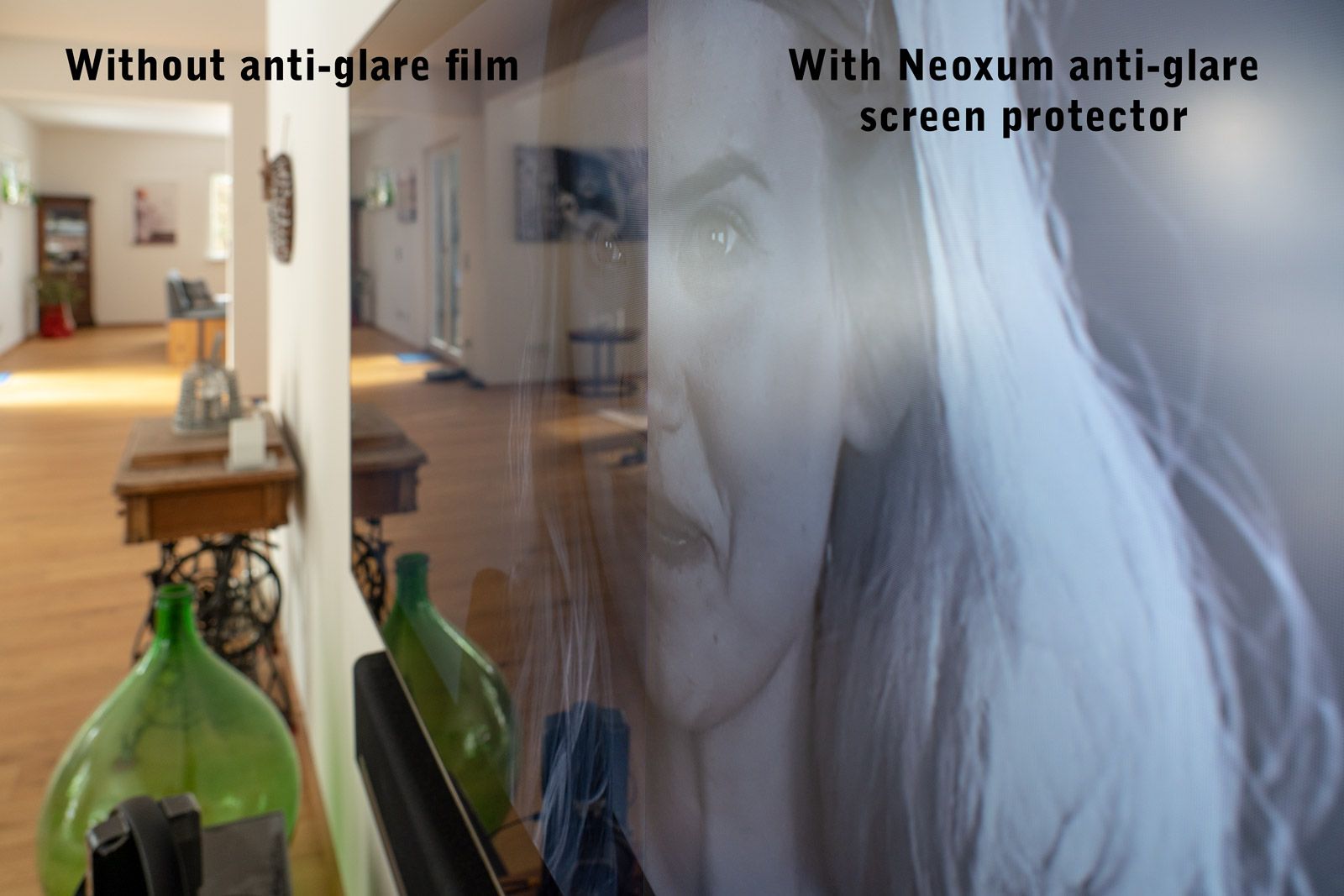
Only the right half of the LCD screen of the LCD TV Samsung UE55D8000 TV has been provided with a Neoxum anti-glare film for demonstration purposes
Objects, like the green glass jar, are sharply outlined and reflected on the screen. The surroundings of the living room can also be perceived very well as a reflection. The border between the left reflective half of the display and the right half of the screen with the applied anti-reflective Neoxum display film runs exactly from top to bottom through the actress' nose. Comparing the two eyes of the woman, it quickly becomes clear that the left eye is almost completely covered by a reflection of a mural. The contrast is greatly reduced. The left eye can only be guessed at. Watching TV in daylight with many reflections on the TV screen is almost impossible. Only after applying the special anti-glare film the screen reflections are effectively scattered: the right eye of the actress is clearly visible in the picture and stands out prominently. Punctual reflections are strongly diffused by the special matt display film, so that incident light at the air-glass interface of the TV screen is no longer reflected according to the law of entry angle = exit angle, but is extremely strongly diffused. As a result, surfaces as well as point light sources are no longer perceived as disturbingly reflective. Television is also possible in daylight. With the help of such anti-reflective screen protection films, reflections can be reduced by up to 85 percent..
Antireflection foil from Neoxum
The AGS (Anti-Glare Protective Film) anti-glare display film provides anti-reflective protection and protects sensitive displays at the same time. Due to a special surface treatment, annoying reflections on the display are very well reduced, so that even outdoors the display becomes legible again. The following video illustrates the anti-glare effect of the Neoxum display film with a very strong point light source, an LED lamp.
The anti-reflective film diffuses incident artificial light or daylight (even direct sunlight!) on the surface, so that the display can be read. The anti-reflective display film does not distort the display colors! An important point for graphic artists, photo artists or users in the field of cartography.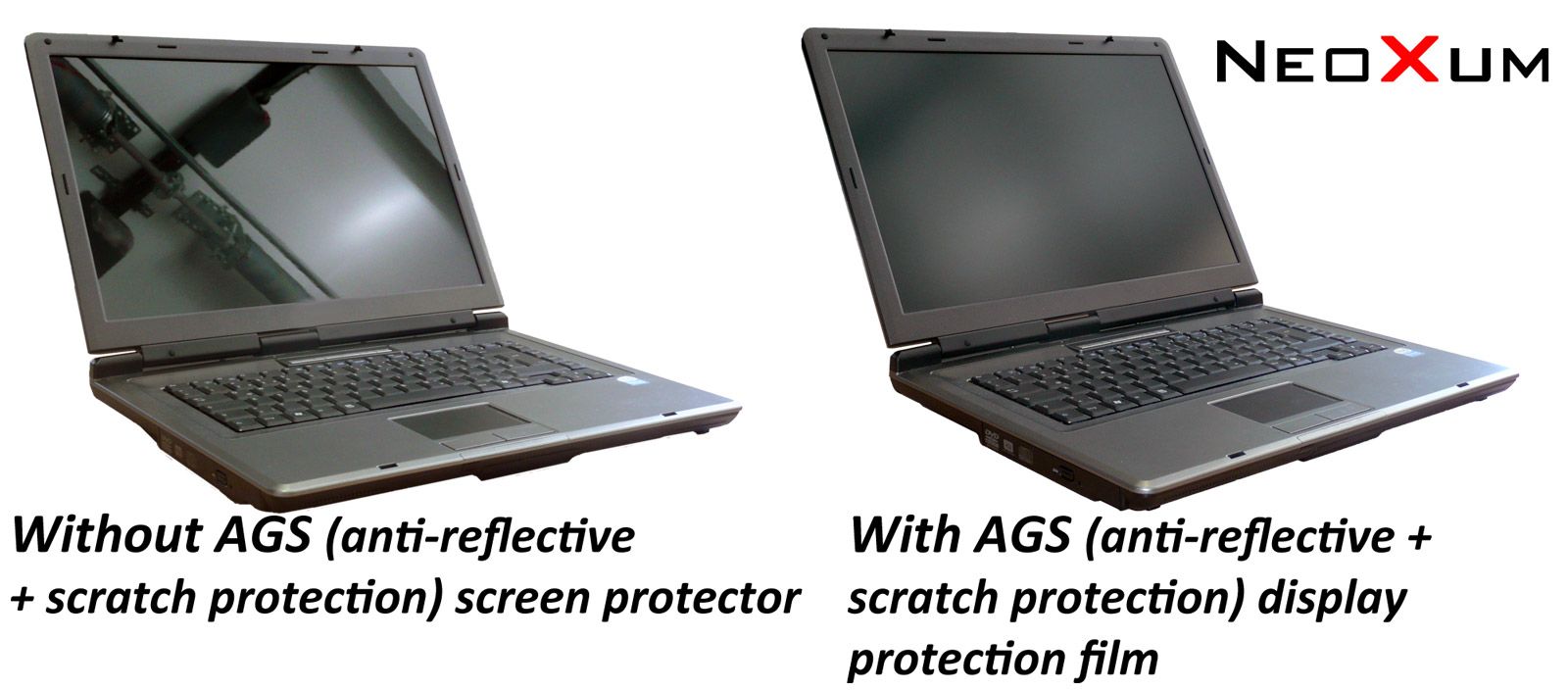
Aktuelle Entwicklungen 2024 zum Thema matte Displays ab Werk
In einem ausführlichen Blogbeitrag haben wir uns dem Thema angenommen, ob Entspiegelungsfolien überflüssig werden, wenn doch Samsung matte Displays für seine OLED TV Geräte in 2024 auf den Markt bringt (Heise News vom 13.01.2024). Soviel vorneweg: Es wird (leider) immer noch spiegelnde Displays geben, die mittels Neoxum Entspiegelungsfolien entspiegelt werden können…
OnScreen® Hybridglas entspiegelnd
As a highlight, we can also offer our high-tech material hybrid glass in an anti-reflective variant. Thus, we achieve a further increased robustness of the applied display protection with the help of the novel hybrid glass, which combines the advantages of a high-performance film with the advantages of glass: very flexible and yet a glass-hard surface.
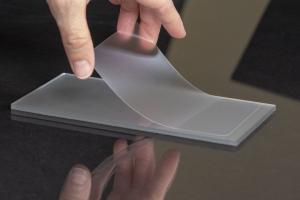
OnScreen hybrid glass in the anti-glare finish effectively reduces distracting reflections and provides a glass-hard surface
Our technical data sheets, test reports and certificates can be found in our download area. Most of the documents are also available in English.
Color fidelity and transparency
Wie sieht es mit der Farbbrillanz bei den antireflektierenden Schutzfolien aus, da diese ja etwas milchig aussehen?
Ein kurzer Ausflug zum Thema Farbe, Farbton und Farbempfinden
The human perception of color is characterized by 1. hue, 2. brightness and 3. color saturation. These three parameters describe the basic individual color perceptions of human beings. The brilliance of a color is thus a subjectively perceived phenomenon and describes the apparent intensity of color perception ("how saturated do colors appear"). Since color brilliance is perceived rather subjectively, the anti-glare AGS display protection foils were subjected to an objective measurement, the measurement of transmission ("how much light is absorbed by the protection foil"). Using UV-VIS spectroscopy, measurements were made in the visible spectral range of 400-850 nm. The results are shown below in graphical form:
The light transmittance in the important visible area is greater than 93% on average. This implies that despite the anti-reflective film, the underlying display only loses a maximum of 7% of brightness - and that with 1. preserved color fidelity and 2. strongly reduced reflections on the display. If it was previously impossible to read anything on the display in sunlight (because it was highly reflective), this is again possible with the anti-reflective film from Neoxum.
Color fastness
We also commissioned several Photoshop artists and photographers to test the Neoxum anti-reflective protective films on their monitors as well as on a camera display. The Apple community confirmed that there is a minimal color deviation, which can be easily compensated for by fine-tuning (no comparison with real color distortions that occur with competitors - violet cast). The well-known photographer and Photoshop artist Xomi (aka Michael Baierl) with his own Video2Brain videos recommends Neoxum AGS (Anti-Glare) films in his workshops to minimize the reflections of Apple device displays.
In addition, thousands of Neoxum anti-reflective films are used for large-format Apple monitors, such as Apple iMac 21.5 inch and Apple Cinema 27 inch at one of the largest publishing houses in Europe, to reduce annoying light reflections.
Comparison antiglare and crystal clear display film
The direct comparison between the anti-reflective screen protection film and the crystal clear variant shows that the anti-glare coating efficiently reduces reflections. The crystal clear film without the special anti-reflective coating is clear and transparent. Both film types are made of the same extremely resistant material.
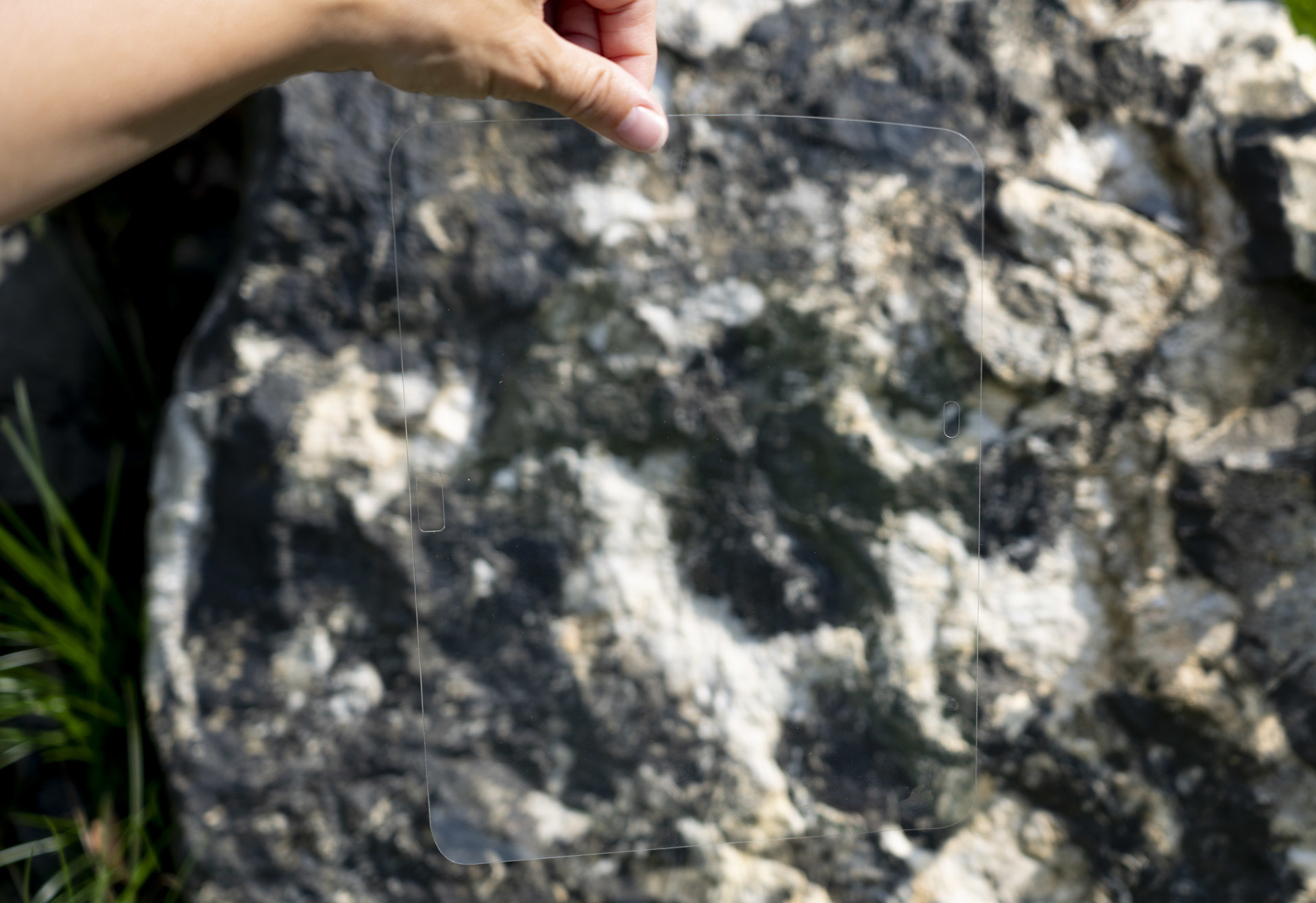
Crystal clear Neoxum screen protector
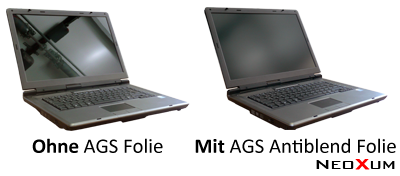
Quality
How many protective films are in one packaging unit?
3er Pack? 5er Pack? 24er Pack? Wie viele Folien sind in einer Verpackung?
Auf Grund der hohen Qualität der Schutzfolien wird lediglich eine Folie pro Display in der Retail Verpackung geliefert, d.h. wenn das Gerät zwei Displays besitzt, so werden auch zwei passgenaue Folien in sehr hoher Qualität geliefert. Die bebilderte Anleitung zur Montage der Folien auf dem Display sowie jeweils ein Feucht- und Trockenreinigungstuch für die Reinigung des Displays vor Montagebeginn werden ebenfalls mitgeliefert.
Neoxum setzt auf recyclingfähige Kartonagen- und Papierverpackungen, die die Displayschutzfolien während des Transports optimal schützen. Wir legen sehr viel Wert auf Sustainability und aus diesem Grund sind wir natürlich auch dem Dualen System angeschlossen, d.h. wir haben bereits das Recycling der Verpackung der professionellen Schutzfolien und der Schutzfolien selbst bezahlt. Sie können die Verpackungen somit dem Papier Kreislauf über allgemeine Papier und Pappe Sammelstellen zuführen. Nach jahrelangem Gebrauch werden auch die besten Folien irgendwann verschleißen. Auch dann können Sie die Folien dem Kunststoffrecycling bedenkenlos zuführen. Auf nervige, umweltschädliche und schwer zu öffnende Kunststoffumverpackungen verzichten wir bewusst.
Vorteil hochwertiger Schutzfolien – Antireflex oder klar
Neben der effizienten Entspiegelung mit einer Antireflex Folie von Neoxum ist das Display auch vor mechanischen, physikalischen und chemischen Einflüssen geschützt. Eine glasklare Neoxum Schutzfolie ohne Antiblend Beschichtung ist ebenso robust und haltbar aber vollkommen klar und transparent.

Gerade dann, wenn der Besitzer unter Umständen überlegt, das Gerät nach einer bestimmten Zeit wieder zu verkaufen oder das Ende des Leasings nähert sich, bleibt der Wert des Gerätes erhalten. Ein Gerät mit Kratzern im Display kauft man ungern oder nur zu stark reduziertem Preis. Bei einem Leasingvertrag sind mitunter hohe Abstriche und Nachzahlungen zu leisten, wenn das Display oder der Touchscreen Kratzer oder gar Risse aufweist. Die Folien sind aus einem Spezial Material hergestellt, dass zum Einen sehr widerstandsfähig ist und zum Anderen völlig ungiftig ist. Getränkeflaschen aus Kunststoff bestehen aus dem gleichen Grundmaterial wie die Neoxum Schutzfolie (PET – Polyethylentherephthalat).
Verdünnte Säuren, verdünnte Laugen, Fette, Öle, Lösemittel und Reinigungsmittel können den Neoxum Display Schutzfolien nichts anhaben.* Ausführliche Testberichte und Tests zu Neoxum Folien finden Sie im Bereich Download. Ebenfalls im Downloadbereich finde Sie das Datenblatt in Englisch, sowie das technische Datenblatt in Deutsch.
*keine Dauerbelastung, eigene Test werden empfohlen
Haftung / Klebkraft Neoxum Displayschutz
Adhäsionskräfte auf Oberflächen
Neoxum Displayschutzfolien und unser OnScreen ® Hybridglas haften rein über physikalische Adhäsion d.h. die Folien saugen sich über eine Art “Saugfuß im Nanometerbereich“ am Display an, ohne jeglichen Einsatz von Klebern oder Klebstoffen, fest. Beim Entfernen von Neoxum Displayschutz Folien oder Hybridglas vom Display bleiben keinerlei Rückstände auf dem Display zurück.
Physical Chemical Forces
Genauer gesagt spielen mehrere physikalisch-chemische Kräfte eine Rolle. Die Adhäsion ist ein grundlegendes Phänomen im molekularen Bereich, die durch polare Wechselwirkungen an Grenzflächen entstehen, in unserem Fall der Grenzfläche Displayoberfläche Silikonhaftschicht der Neoxum Displayfolie, bzw. OnScreen ® Hybridglas, sogenannte Van-der-Waals Bindungen zwischen Molekülen der Displayoberfläche und Molekülen der Adhäsionsschicht (der sehr dünnen Silikonhaftschicht). Der entschiedene Faktor bei Adhäsion ist dabei die räumliche Nähe der beiden Oberflächen. Die Silikon Adhäsionsschicht von Neoxum Displayschutz, bzw. Oberflächenschutz, ist so geartet, dass unsere Displayfolien, sowie unser Hybridglas, auf vielen glatten Materialien, wie Kunststoffen, Metallen aber auch Glas sehr gut haften. Von allen Materialtypen lässt sich die Adhäsionsfolie und das Hybridglas rückstandsfrei wieder entfernen.
Schichtaufbau Neoxum Schutzfolie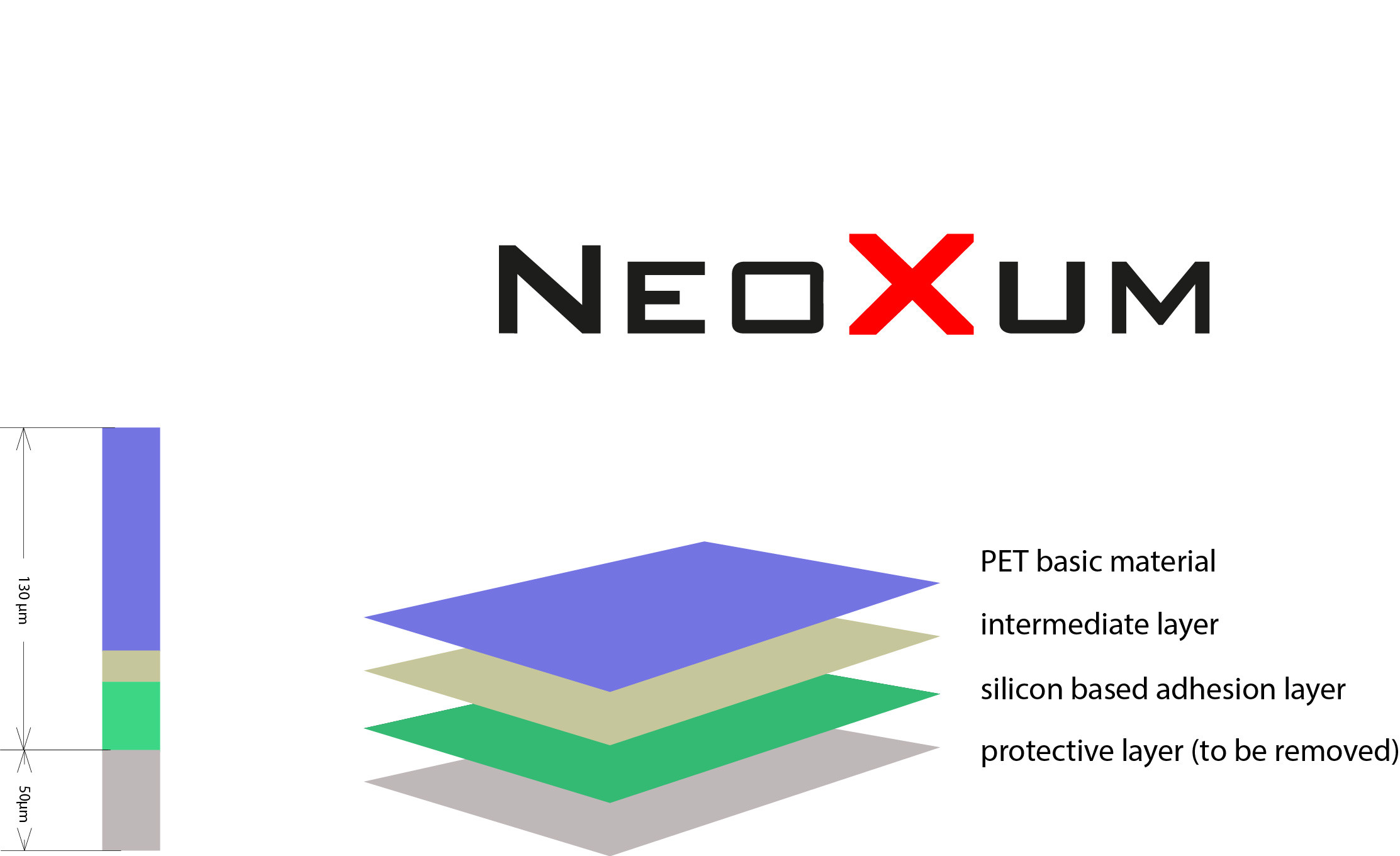
Schichtaufbau OnScreen ® Hybridglass
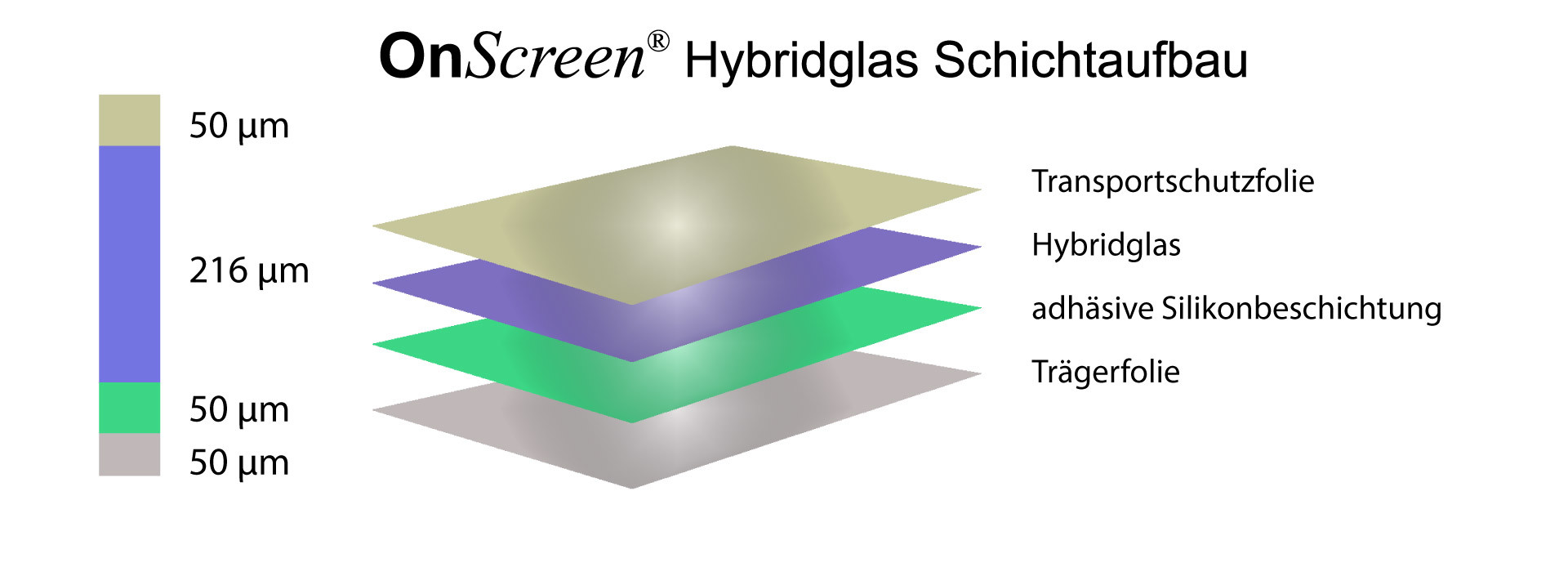
Why is that
Commercially available simple adhesive films usually have an adhesive layer made of acrylate adhesive or modified acrylate. This adhesive layer exerts much stronger physical bonds than the adhesive forces of the adhesive films. This type of acrylic adhesive film usually CANNOT be removed from displays without leaving residue after a few weeks or months of use.
Quality first, quantity second
High quality industrial grade display protection
We are not talking about foils that are sold on various platforms for €2.95 for 12 pieces. In general, the question arises why you need 12 foils as a user. This can only mean that the quality of the cheap film is in the range of better cling film and has nothing to do with industrial and professional protection or an effective anti-reflection effect.
Neoxum anti-reflective and crystal clear films are made of special completely non-toxic or non-irritating polymer that meets industry standards. Manufactured in Germany according to DIN ISO 9001 quality standard.
We summarized the key features, as well as a technical data sheet, in the download area.
Haltbarkeit der Neoxum Displayschutz Folien
Bei normaler Nutzungsintensität und Beanspruchung hält die Folie ein Geräteleben lang. Sollte die Folie dennoch bei starker Beanspruchung Kratzer abbekommen (nur die Folie – nicht das Gerätedisplay!) kann die Schutzfolie sehr einfach erneuert werden. Die enorme Haltbarkeit und Beständigkeit, verbunden mit der sehr hohen Chemikalienbeständigkeit des Spezialkunststoffes sorgen für einen perfekten Schutz und Lesbarkeit des Displays. Neoxum Displayschutz ist enorm robust und schützt Displays von elektronischen Geräten vor mechanischer Beschädigung.
Für viele Hersteller und Modelle können Sie den Neoxum Displayschutz ganz bequem bei unserem Partner ![]() online erwerben
online erwerben
Gerne nennen wir Ihnen auf Anfrage namhafte Customer references.
Do I still have to cut the Neoxum screen protectors myself?
The screen protecting foils do not have to be cut to size yourself! Both the anti-reflection AGS and the crystal-clear AS protective film are cut to fit precisely using state-of-the-art laser cutting equipment. Cutouts for camera lenses, microphones or speakers are taken into account as well as special corner radii or display shapes and dimensions. We cut your display protection foils as well as the hybrid glass to an accuracy of 0.1 mm, taking into account optimal mounting and all necessary edges, radii and recesses. Of course, we also manufacture special dimensions up to 3000 mm x 1000 mm (for example as privacy film or shatter protection film).
Cutouts for camera, microphone, sensors, outer contour
A modern touch display device with its sensor or microphone, but also a special sensor can do much more than just display an image. All these cut-outs, as well as the exact outer contour of the device display is taken into account with Neoxum products.
Technical information
How many protective films are in one packaging unit?
3er Pack? 5er Pack? 24er Pack? Wie viele Folien sind in einer Verpackung?
Auf Grund der hohen Qualität der Schutzfolien wird lediglich eine Folie pro Display in der Retail Verpackung geliefert, d.h. wenn das Gerät zwei Displays besitzt, so werden auch zwei passgenaue Folien in sehr hoher Qualität geliefert. Die bebilderte Anleitung zur Montage der Folien auf dem Display sowie jeweils ein Feucht- und Trockenreinigungstuch für die Reinigung des Displays vor Montagebeginn werden ebenfalls mitgeliefert.
Neoxum setzt auf recyclingfähige Kartonagen- und Papierverpackungen, die die Displayschutzfolien während des Transports optimal schützen. Wir legen sehr viel Wert auf Sustainability und aus diesem Grund sind wir natürlich auch dem Dualen System angeschlossen, d.h. wir haben bereits das Recycling der Verpackung der professionellen Schutzfolien und der Schutzfolien selbst bezahlt. Sie können die Verpackungen somit dem Papier Kreislauf über allgemeine Papier und Pappe Sammelstellen zuführen. Nach jahrelangem Gebrauch werden auch die besten Folien irgendwann verschleißen. Auch dann können Sie die Folien dem Kunststoffrecycling bedenkenlos zuführen. Auf nervige, umweltschädliche und schwer zu öffnende Kunststoffumverpackungen verzichten wir bewusst.
Haftung / Klebkraft Neoxum Displayschutz
Adhäsionskräfte auf Oberflächen
Neoxum Displayschutzfolien und unser OnScreen ® Hybridglas haften rein über physikalische Adhäsion d.h. die Folien saugen sich über eine Art “Saugfuß im Nanometerbereich“ am Display an, ohne jeglichen Einsatz von Klebern oder Klebstoffen, fest. Beim Entfernen von Neoxum Displayschutz Folien oder Hybridglas vom Display bleiben keinerlei Rückstände auf dem Display zurück.
Physical Chemical Forces
Genauer gesagt spielen mehrere physikalisch-chemische Kräfte eine Rolle. Die Adhäsion ist ein grundlegendes Phänomen im molekularen Bereich, die durch polare Wechselwirkungen an Grenzflächen entstehen, in unserem Fall der Grenzfläche Displayoberfläche Silikonhaftschicht der Neoxum Displayfolie, bzw. OnScreen ® Hybridglas, sogenannte Van-der-Waals Bindungen zwischen Molekülen der Displayoberfläche und Molekülen der Adhäsionsschicht (der sehr dünnen Silikonhaftschicht). Der entschiedene Faktor bei Adhäsion ist dabei die räumliche Nähe der beiden Oberflächen. Die Silikon Adhäsionsschicht von Neoxum Displayschutz, bzw. Oberflächenschutz, ist so geartet, dass unsere Displayfolien, sowie unser Hybridglas, auf vielen glatten Materialien, wie Kunststoffen, Metallen aber auch Glas sehr gut haften. Von allen Materialtypen lässt sich die Adhäsionsfolie und das Hybridglas rückstandsfrei wieder entfernen.
Schichtaufbau Neoxum Schutzfolie
Schichtaufbau OnScreen ® Hybridglass

Why is that
Commercially available simple adhesive films usually have an adhesive layer made of acrylate adhesive or modified acrylate. This adhesive layer exerts much stronger physical bonds than the adhesive forces of the adhesive films. This type of acrylic adhesive film usually CANNOT be removed from displays without leaving residue after a few weeks or months of use.
Montage der Displayfolien
Neoxum protective anti-glare, as well as ultra-clear display films are delivered with detailed and illustrated installation instructions. If you follow these instructions, the application is very simple and can be done by non-professionals without any problems. It is recommended that a second person helps with the application of a large display film (from about 14 inches display diagonal) (if you don't have any practice). A low-dust room is recommended for the installation.
Zudem sollte man etwas Zeit mitbringen (2-4 Minuten).



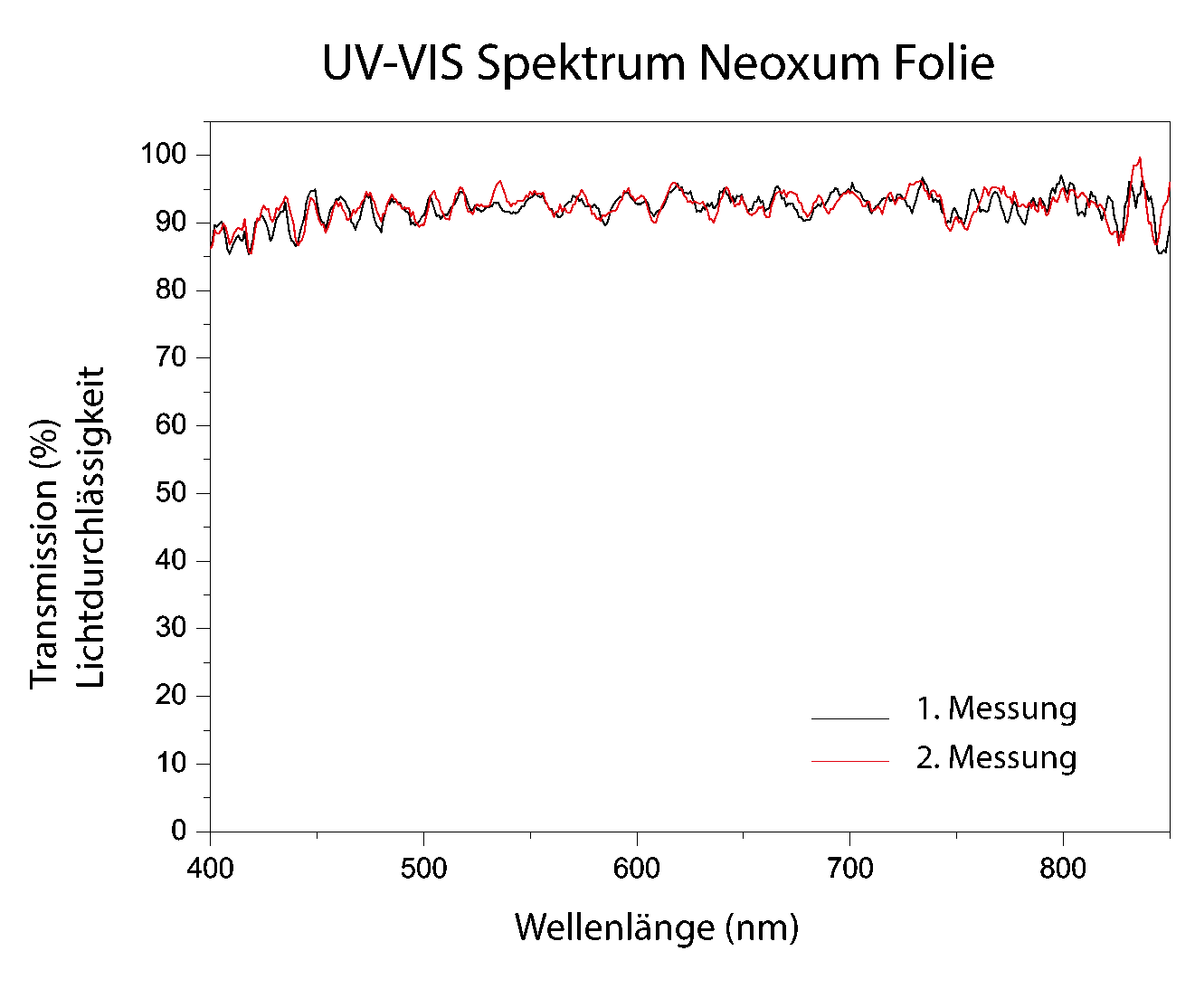
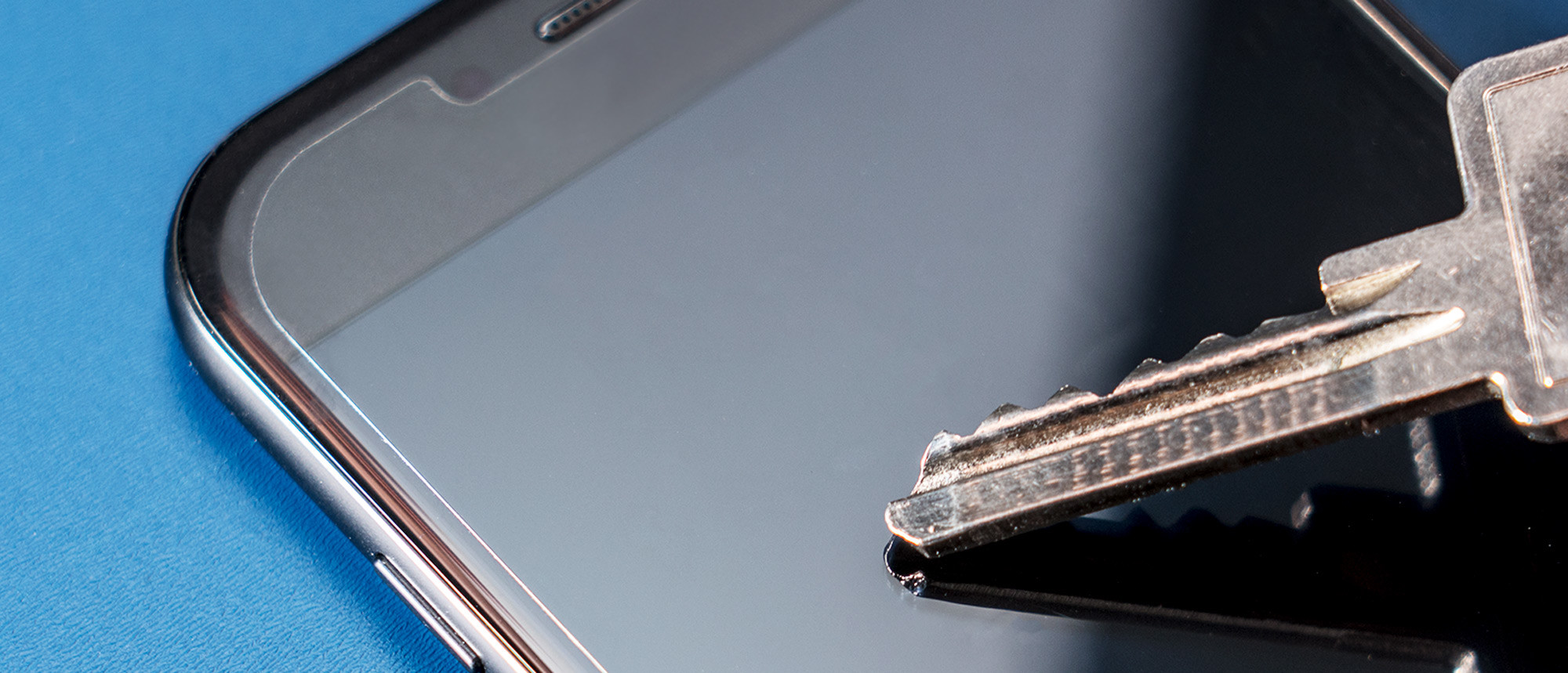
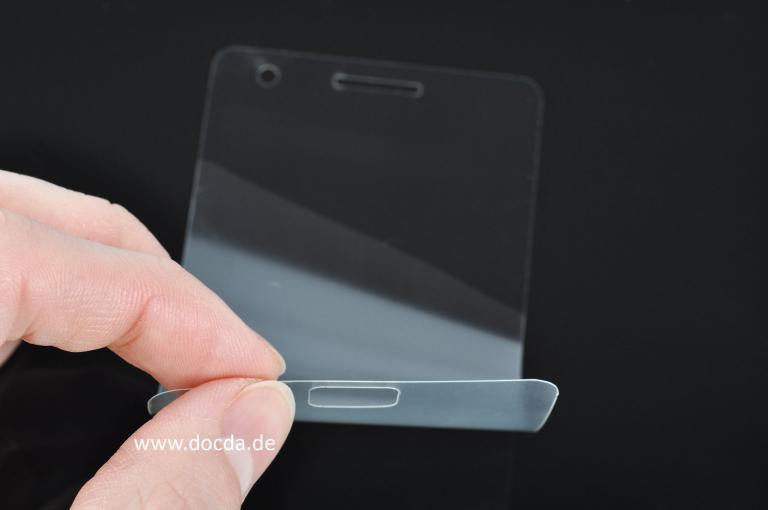
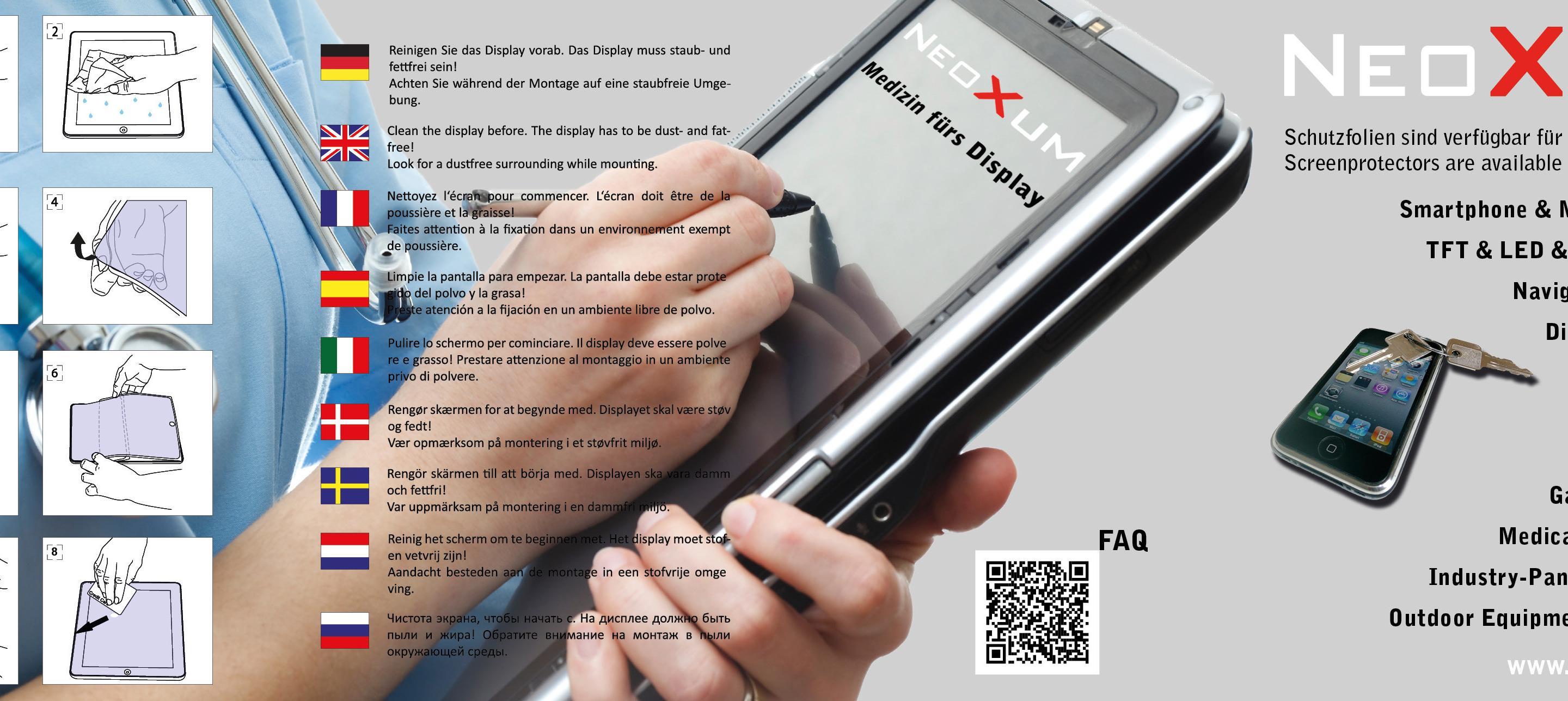
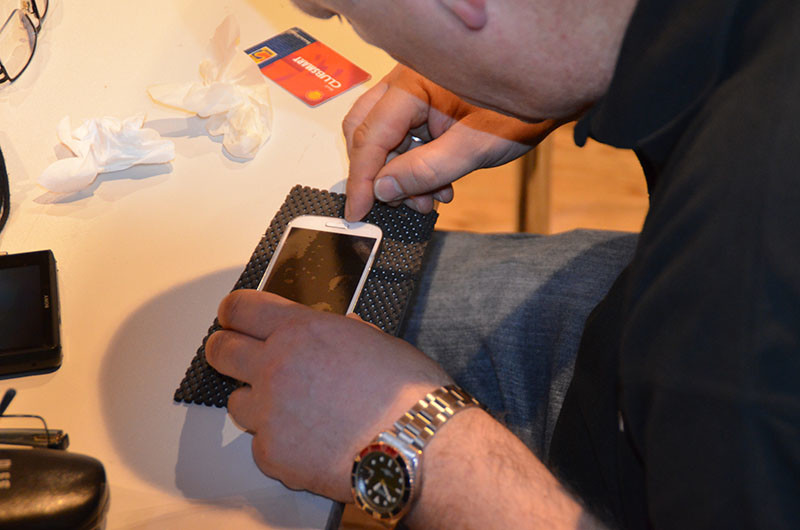
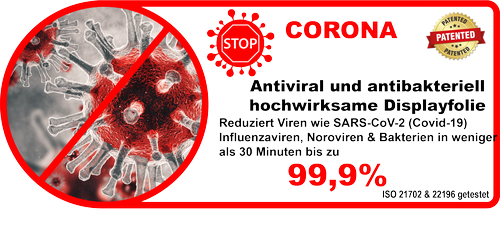
 . A strong 256-bit encryption secures the data transfer. With our externally issued SSL certificate, we are transparent and compliant. In addition to the SSL-secured website, we take data protection very seriously.
. A strong 256-bit encryption secures the data transfer. With our externally issued SSL certificate, we are transparent and compliant. In addition to the SSL-secured website, we take data protection very seriously.